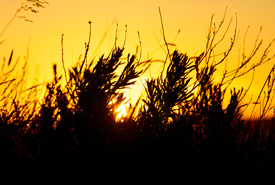Indigenous-led conservation: Part of the path forward

Sagebrush at sunset (Photo by Sean Feagan / NCC Staff)
The pathway to Reconciliation is long and complex, but Indigenous-led conservation — reforging connections between people and landscapes — can help forge the way. AnnLisa Jensen, Métis, member of the Métis Nation of Alberta and the Nature Conservancy of Canada’s (NCC’s) Indigenous conservation program manager in Alberta, recently spoke about Indigenous-led conservation and its relation to Reconciliation.
Special thanks to Calgary Foundation, Alberta Ecotrust Foundation, Keyera Corp, the Government of Canada’s National Heritage Conservation Program and the Barbara and John Poole Foundation for supporting the Nature Conservancy of Canada’s Indigenous Conservation Program.
Q: What is Indigenous-led conservation?
A: Indigenous-led conservation is just that — it is shifting the paradigm of conservation, which has traditionally been associated with the displacement and systematic removal of Indigenous Peoples from the land and traditional territories. This created a disconnection between Indigenous communities and the land on which they lived and sustained respectful stewardship practices since time immemorial.
Indigenous-led conservation prioritizes self-governance and an approach to land in a way that reflects Indigenous ways of life and Traditional Knowledge, and connects communities back to it in meaningful ways. It is intrinsically linked to self-determination, the exercise of inherent rights and the revitalization of cultures. This reconnects Indigenous people to the land, and ensures that they are rightfully active in land and water protection, stewardship, restoration and ensuring biodiversity, to benefit future generations.
Indigenous-led conservation includes collaborations with various governments, non-governmental organizations, such as NCC, philanthropic funding sources and the corporate sector to achieve conservation goals.
There are many examples of Indigenous-led conservation initiatives across Canada, and NCC has been successfully partnering with Indigenous Nations and communities for more than a decade. There are many ways NCC can support Indigenous-led conservation, and it really is a new and exciting time to discover and determine new and even more effective ways to work together.
Q: Why is it important?
A: It is just the right thing to do. Indigenous-led conservation and collaboration on the land must be foundational to NCC’s values, principles and work, moving forward.
Conservation and protection goals established by government and organizations, such as NCC, can be met much more effectively with not just the inclusion of, but the leadership, guidance and management by Indigenous Peoples.
Q: What is its role in relation to Reconciliation?
A: Land conservation is essentially linked to Reconciliation between non-Indigenous and Indigenous Peoples. There is the significant opportunity — and the necessity — to address the historical forced removal of Indigenous Peoples from their lands and the fundamental promises of the Treaties. Moving forward with a renewed vision of conservation that focuses on building trust, understanding and positive relationships and seeks opportunities for partnership in stewardship and conservation will begin to address historic wrongs and return land, rightfully, to Indigenous Peoples, who were innately connected to the land and water for thousands of years.
Supporting and partnering in Indigenous-led conservation supports self-determination and the essential reconnection to land, revitalization of culture and the health of Indigenous communities with the return to Traditional Knowledge and Indigenous worldview.
The Truth and Reconciliation Commission’s Final Report addresses not just the need to recognize the inter-generational trauma inflicted on Indigenous Peoples by residential schools, but also the historic practice of removing Indigenous Peoples from their traditional territories.
Because NCC is a land conservation organization, we are naturally in the right place to support the right to self-determination and acknowledge those historic wrongs that have occurred, with a transformative shift in how land acquisition has traditionally taken place to one that is Indigenous-led and based on consent and partnership development. This has been happening for many years at NCC, but there is a genuine recognition of the need to move this to the forefront of how we approach conservation projects in what is an important time into the future.




